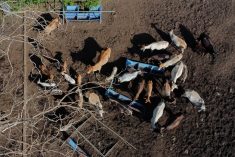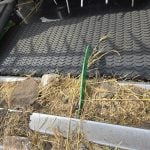Farmers who built North East Terminal Ltd. wanted to see more competition among grain buyers in their corner of Saskatchewan.
Last year, to their chagrin, they saw it.
The four-year-old farmer-owned company, based in Wadena, Sask., has reported a loss of $399,285 for the year that ended July 31, 1996.
Export grain shipments are the terminal’s bread and butter, and such shipments were down for all grain handlers last year. But NET’s disastrous financial results are also due in large part to the intense competition for grain in the Wadena area, said company president Dwayne Anderson.
Read Also

Saskatchewan agriculture sector receives federal funding
PrairiesCan funding will assist in the continued growth of Saskatchewan’s ag research and manufacturing sectors.
“One of the reasons we were built was to create competition and we’ve sure done it,” he said in an interview. “The farmers are definitely benefiting.”
Rationalization of the area’s elevator system has not gone ahead as quickly as had been anticipated when the 25,600-tonne terminal was built, said Anderson.
Another unexpected development was the decision by U.S.-based multinational Archer Daniels Midland to build a canola collection station at Watson, just 50 kilometres west of the terminal, to service its crushing plant at Lloydminster. That knocked NET out of the canola market.
Buying market share
“They were buying market share,” Anderson said. “If you’re going to try to stand in there with a fairly big company and buy at a loss all year, we would have had an even worse financial statement.”
The company has also been hurt by the railways’ decision to cut back on the rate discounts for loading and shipping large blocks of cars, something that NET and other inland terminals had counted on in their business plans.
“When we don’t have the freight rate incentives to buy the grain from a little further down the road we have a hard time competing,” he said.
Sales and operating revenue for 1995-96 were down 25 percent to $19,693, reflecting a 25 percent drop in handlings to 84,000 tonnes. The previous year’s net income was $2,584, while two years ago the company earned more than $250,000. Of the $399,285 net loss, about $340,000 was depreciation.
Anderson said the company saw the situation developing early in the year and tried unsuccessfully to launch programs to attract grain.
“We just could not buy the tonnage,” he said. “It was a very, very competitive marketplace.”
So far this year, things are looking up. The company has a new line of credit and grain handlings are setting a record pace.
Good volumes of oats have been shipped to the U.S. this fall, exports of wheat and barley should be up and the terminal’s grain dryers will produce significant revenue.
“We’re on track to have a modestly profitable year,” said Anderson.
The Fosston, Sask., farmer said he still believes the most cost-effective way to put grain into export position is to do it through a high throughput plant shipping large unit trains of cleaned grain. But the experience of 1995-96 shows that a stand-alone grain handling facility is extremely vulnerable to fluctuations in volume.
“It’s been a soul-searching year,” said Anderson. “When you lose nearly $400,000 on an operation the size of ours, it’s not a good signal.”














